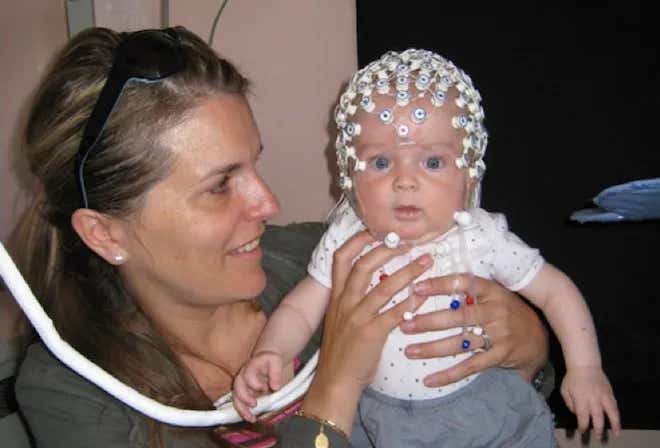Researchers believe they now know when babies become conscious
Researchers have put forward an innovative approach aimed at aiding scientists in pinpointing the onset of consciousness in babies.

Researchers have put forward an innovative approach aimed at aiding scientists in pinpointing the onset of consciousness in babies. (CREDIT: Sofie Gelskov)
Researchers are delving into the enigmatic question of when consciousness emerges in human infants, proposing a novel method to shed light on this elusive phenomenon.
The inquiry into the timing of consciousness has intrigued thinkers for centuries, dating back to the musings of seventeenth-century philosopher René Descartes, who speculated on the cognitive capacities of infants compared to adults. Today, this inquiry remains a central puzzle for psychologists and philosophers alike.
In response to a recent article in Trends in Cognitive Sciences, academics from the University of Birmingham have put forward an innovative approach aimed at aiding scientists in pinpointing the onset of consciousness in babies.
The most compelling evidence for early emergence comes from studies of: (i) functional connectivity networks in fetuses [143.] and newborns [40.,41.]; (ii) attention in young infants [53.,144.]; (iii) multisensory integration in young infants (namely, the McGurk effect) [59.,60.]; and (iv) global neural prediction errors in fetuses [65.], newborns [64.], and young infants [63.]. (CREDIT: Trends in Cognitive Sciences)
Dr. Henry Taylor, Associate Professor of Philosophy, and Andrew Bremner, Professor of Developmental Psychology, proposed this method in a Letter to the Editor, also published in Trends in Cognitive Sciences.
Their approach involves identifying markers of consciousness observed in adults and tracking the emergence of similar markers in infants during their developmental stages.
Dr. Taylor explains the rationale behind this approach, stating, “For example, imagine that in adults, we know that a certain very specific behavior, or a specific pattern of brain activation always comes along with consciousness. Then, if we can identify when this behavior or brain activation arises in babies, we have good reason to think that this is when consciousness emerges in babies. Behaviors and brain activations like this are what we call ‘markers’ of consciousness.”
Related News
The challenge in assessing infant consciousness lies in the fact that babies cannot articulate their experiences, making traditional methods of inquiry impractical.
Professor Bremner highlights this difficulty, stating, “It is really hard to establish when babies become conscious. This is mostly because infants can’t report their experiences and, as most parents will know, can be rather uncooperative particularly when it comes to experimental tasks.” Given this limitation, the researchers advocate for identifying a diverse array of markers of consciousness that manifest across early and late stages of development.
In the recent article by Prof. Tim Bayne and colleagues, four specific markers of consciousness were suggested, some observable in the late stages of gestation and others in early infancy.
Examples of techniques for recording brain activity and/or neuroimaging in infants and fetuses. Infant electroencephalography (EEG) with a geodesic electrode net (laboratory of Shafali Jeste). Fetal magnetoencephalography (MEG) recorded from a pregnant woman (University Hospital Tübingen). (CREDIT: Trends in Cognitive Sciences)
This study posited that consciousness emerges early, possibly even from the last prenatal trimester. However, Professors Bremner and Taylor argue that this perspective overlooks additional markers of consciousness identified in previous research.
These alternative markers include pointing, intentional control, and explicit memory. Dr. Taylor emphasizes the complexity of the issue, stating, “One of the complicated issues is that it does not look like all the markers point to the same age for the emergence of consciousness. The ones mentioned by Bayne and colleagues suggest somewhere between the third trimester of pregnancy and early infancy, but other markers suggest the age might be around one year old. In fact, at the really extreme end, some markers only emerge at around 3-4 years.”
Infant functional near infrared spectroscopy (fNIRS) recording with multichannel optodecap (AIupscaled from [133]). An infant is prepared for functional magnetic resonance imaging (fMRI) (AI upscaled from [137]). Abbreviation: AI, artificial intelligence. (CREDIT: Trends in Cognitive Sciences)
Professor Bremner concludes by advocating for a comprehensive approach to marker identification, incorporating those that manifest in both early and late developmental stages.
He suggests considering various developmental models of consciousness onset, positing that certain markers may emerge in clusters at different points in development. Additionally, he proposes the possibility of a continuous and gradual emergence of certain markers spanning gestation and early life.
“We think that by clustering this broad selection of markers, we may finally be able to answer the question which has given us pause for thought for thousands of years. But it’s important to bear in mind that the answer may not be a simple one!” Professor Bremner cautions, underscoring the complexity of unraveling the mystery of infant consciousness.
For more science news stories check out our New Innovations section at The Brighter Side of News.
Note: Materials provided above by The Brighter Side of News. Content may be edited for style and length.
Like these kind of feel good stories? Get the Brighter Side of News' newsletter.
Joshua Shavit
Science & Technology Writer | AI and Robotics Reporter
Joshua Shavit is a Los Angeles-based science and technology writer with a passion for exploring the breakthroughs shaping the future. As a contributor to The Brighter Side of News, he focuses on positive and transformative advancements in AI, technology, physics, engineering, robotics and space science. Joshua is currently working towards a Bachelor of Science in Business Administration at the University of California, Berkeley. He combines his academic background with a talent for storytelling, making complex scientific discoveries engaging and accessible. His work highlights the innovators behind the ideas, bringing readers closer to the people driving progress.



